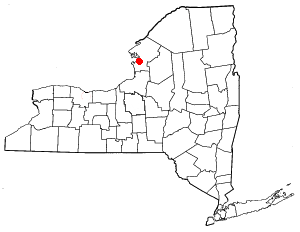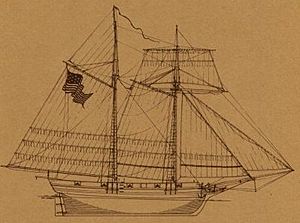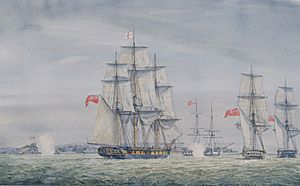First Battle of Sacket's Harbor facts for kids
Quick facts for kids First Battle of Sacket's Harbor |
|||||||
|---|---|---|---|---|---|---|---|
| Part of War of 1812 | |||||||
 Map of New York, the red dot is Sackets Harbor. |
|||||||
|
|||||||
| Belligerents | |||||||
| Commanders and leaders | |||||||
| Strength | |||||||
| 2 sloops-of-war 1 brig 2 schooners |
Land: 1 shore battery 1 regiment of regulars 1 company of artillery 3,000 militia Sea: 1 brig |
||||||
| Casualties and losses | |||||||
| 8 killed 1 warship severely damaged Other ships damaged to unknown extent |
None | ||||||
The First Battle of Sacket's Harbor was an important fight during the War of 1812. It happened on July 19, 1812, between the United States and the British Empire. This was the very first time these two sides fought each other in the war. American forces successfully defended the village and its vital shipbuilding area. This shipyard was where 12 warships were built for the war effort.
Contents
Why Sacket's Harbor Was Important
Sacket's Harbor is a village located on the southeast shore of Lake Ontario. This area is in Northern New York State. It became the main place for the United States to build warships during the War of 1812. Twelve warships were built there during the conflict.
The village had a great location on the lake. It also had plenty of natural resources and an excellent natural harbor. Because of this, the small village, with only a few hundred people, grew very quickly. It became the main center for military and naval operations in the northern part of the war.
After this first battle, the village and harbor became a large military base. Thousands of troops and 3,000 workers were at the shipyard. Sacket's Harbor became the fourth largest town in New York State during this time.
British Demands and Threats

On July 19, 1812, Captain Melancthon Taylor Woolsey was on his ship, USS Oneida. From the top of his ship's mast, he saw five enemy ships sailing towards Sacket's Harbor. These British ships belonged to the Provincial Marine. They were the Royal George (with 24 guns), Prince Regent (22 guns), Earl of Moira (20 guns), Governor Simcoe (10 guns), and Seneca (2 guns).
The British captured a merchant ship nearby that was carrying flour. They sent its crew to shore with a message. The British demanded that the U.S. surrender USS Oneida and Lord Nelson. Lord Nelson was a merchant ship that U.S. forces had captured before the war began. The British warned that if even one shot was fired at them, they would burn the village of Sacket's Harbor.
The Battle Begins
The British fired the first shots at the American brig Oneida. The Oneida tried to escape the approaching British ships but could not. It returned to Navy Point. The British ships continued on and dropped their anchors.
At Navy Point, the Oneida was tied up with one side of its nine guns facing the enemy. The other guns were quickly taken off the ship. They were placed on a low wall, called a breastwork, along the shoreline. Near this wall, a large 32-pounder cannon was set up. This cannon was meant for the Oneida but was too heavy for the ship. A protective dirt mound, about 6 feet (1.8 meters) high, was built below the cannon.
American Defenses and Preparations
Alarm guns were fired to warn everyone. Messengers were sent out to call in the local militia (citizen soldiers). Most of the militia did not arrive in time to help with the battle. However, by the end of the day, about 3,000 local militia had gathered. They did not take part in the fighting.
The British had been given wrong information about the harbor's defenses. They thought there were no strong cannons to worry about. The American forces in town included the crew of the Oneida, a regiment led by Colonel Bellinger, a volunteer artillery company led by Captain Camp, and the local militia.
Captain Woolsey left his ship, the Oneida, in the care of a lieutenant. He then took command on shore. The large 32-pounder cannon was managed by William Vaughan, a sailing master. The other guns were under the command of Captain Camp.
There were no cannonballs in town larger than 24-pound balls. So, these smaller balls were used in the 32-pounder cannon. They used patches made of carpet to make the balls fit tightly. By the time these preparations were finished, the enemy ships were close enough to fire, right in front of the American battery.
The Fight and British Retreat
The battle began. The first shot was fired from the 32-pounder cannon. It missed all the British ships. A loud laugh was heard from the British fleet, showing they thought the American shot fell too short. The British quickly fired back at the American battery. They continued firing for two hours. Reports said that most of the British shots were accurate.
The Americans fired back throughout the attack. The Oneida's side guns and their 32-pounder cannon hit or nearly hit the British ships many times.
Towards the end of the battle, the main British ship, the Royal George, was moving to fire another round of shots. A 24-pound cannonball hit its back end and went through the entire ship. This killed eight men and caused a lot of damage. The Royal George also had serious damage to its top mast and ropes. Other British warships were damaged too, but how much is not known.
After this, the British signaled to retreat. The British fleet quickly sailed away towards Kingston, Upper Canada. The American band started playing the national song "Yankee Doodle," and the troops cheered loudly three times for their victory.
After the Battle
On July 24, 1812, General Jacob Brown praised the success of the day. He gave credit to officers Woolsey, Bellinger, and Camp for their roles. He especially thanked the crew of the 32-pounder cannon.
William Vaughan, who had commanded the 32-pounder, was proud to have fired the first enemy shot of the war. Julius Torry, one of the men at this gun, was an African American known as Black Julius. He was very popular in the camp. He worked at his post with great energy and bravery. Most of the troops who were lined up did not use their small guns. They watched the battle as spectators.
Protecting the Battlefield
The American Battlefield Trust and its partners have bought and protected 25 acres (0.1 square kilometers) of the Sacket's Harbor battlefield. This helps save this important historical site.



